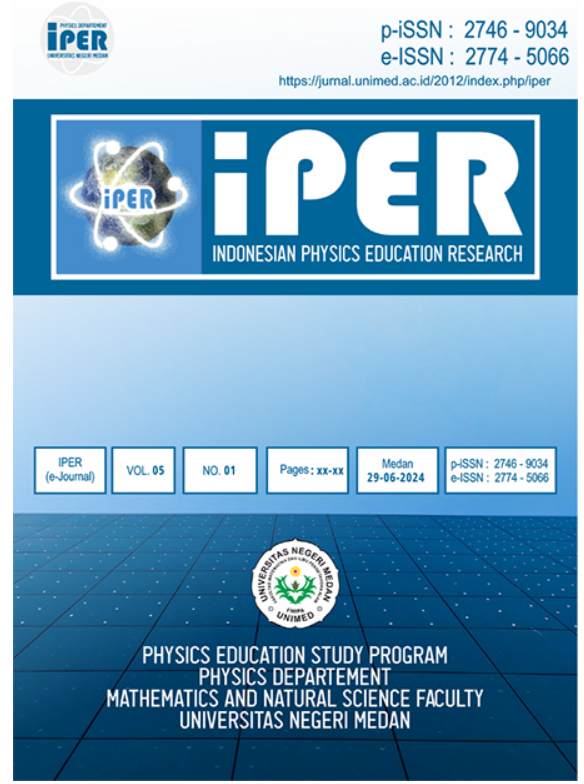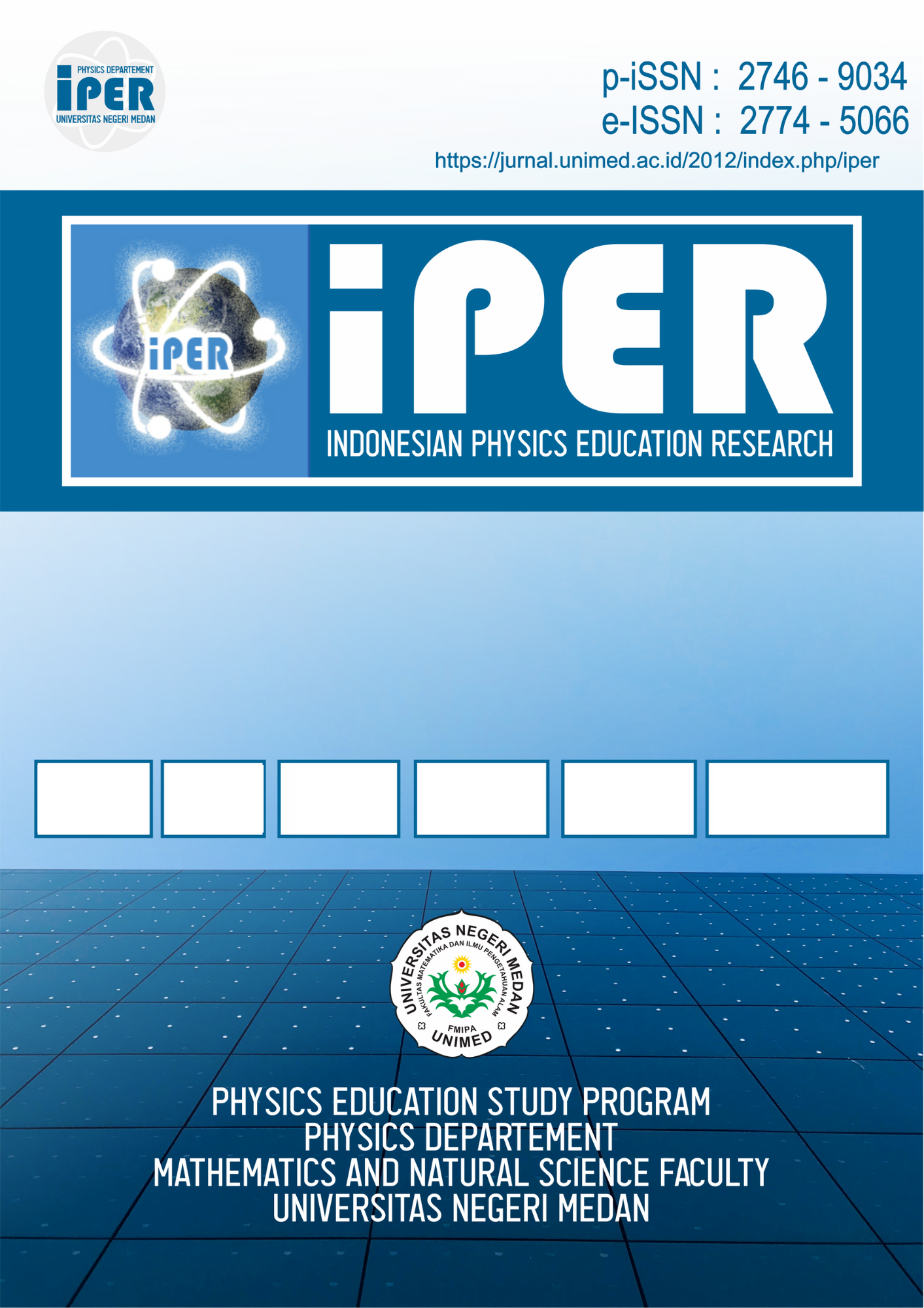DESCRIPTION OF CREATIVE THINKING SKILLS BASED ON CREATIVE THINKING TEST IN OPTICAL MATERIALS
DOI:
https://doi.org/10.24114/iper.v4i2.62998Keywords:
Creativity, Phhysics Concepts, Test InstrumentAbstract
This study aims to describe the creative thinking of high school students in solving physics problems. Creative thinking skills are crucial for developing long-term success and improving the quality of life. This research is qualitative descriptive research, research methods used in research is a qualitative method, participants in this study were students of class XI SMA IPA 2 and IPA 6, totaling 66 students, data obtained from student's thinking creativity test instrument which is strengthened by data from student and teacher interviews. Data analysis referred to three indicators of creativity used in the study: fluency, flexibility, and originality. The results showed that the aspect of fluency exhibits the highest average proportion among the characteristics of creative thinking, while the aspect of originality shows the lowest average proportion. It is necessary to apply various kinds of learning models that are applied to be able to improve students' creative thinking skills. Although there are some students with lower levels of creative thinking, it does not imply that they lack creativity, as creativity can be fostered through other activities.References
Aizikovitsh-Udi, E. &. (2015). Developing critical thinking skills from dispositions to abilities: Mathematics education from early childhood to high school. creative education, 456-461.
Arikunto, S. (2010). Dasar-Dasar Evaluasi Pendidikan. Jakarta: Bumi Aksara.
Astuti, E. P., & Adi Nugroho, A. (2018). Analysis of critical and creative thinking skills in physics problem solving. Journal of Physics: Conference Series, 28-44.
Azhari. (2013). Peningkatan Kemampuan Berpikir Kreatif Matematik Siswa Melalui Pendekatan Konstruktivisme Di Kelas VII Sekolah Menengah Pertama (SMP) Negeri 2 Banyuasin III. Jurnal Pendidikan Matematika, 4-6.
Baum, L. M. (2010). Instructional design as critical and creative thinking: A journey through a Jamestown-Era Native American Village. TechTrends, 26-36.
Collins, R. (2014). Skills for the 21st Century: Teaching higher-order thinking. Curriculum & Leadership Journal, 2-6.
Fitriyani, R., & Indrawati, I. (2018). Analysis of students' creative thinking in solving conceptual physics problems. Journal of Physics: Conference Series, 77-88.
Guildford. (2012). Pengembangan Kreativitas Anak. Jakarta: Rineka Cipta.
Hamzah, A. (2014). Evaluasi pembelajaran Matematika. Jakarta: Rajawali Pers.
Jihad, A. d. (2012). Evaluasi Pembelajaran. Yogyakarta: Multi Pressindo.
Kiryak, Z. &. (2017). Improving grade 7 students™ conceptual understanding of water pollution via common knowledge construction model. International Journal of Science and Mathematics Education,, 2-20.
Landis, J. R., & Koch, G. G. (1977). The measurement of observer agreement for categorical data. Biometrics, 15-74.
Maayah, B., Karim, N., & Makhadmeh, L. (2022). The Role of Problem-Based Learning in Developing Students™ Critical Thinking Skills. International Journal of Instruction, 104-112.
Moma, L. (2015). Pengembangan Instrumen Kemampuan Berpikir. Jurnal Matematika dan Pendidikan Matematika, 32-33.
Munandar, U. (2009). Pengembangan Kreativitas Anak Berbakat. Jakarta: PT. Rineka Cipta.
Navarrete, C. C. (2013). Creative thinking in digital game design and development: A case. Computers & Education, 321-330.
Newcombe, N. S. (2014). Studying visual and spatial reasoning for design creativity: Thinking about spatial thinking. Dordrecht: Springer.
Nurul Fitriani, G. S. (2017). Berfikir Kreatif Dalam Fisika Dengan Pembelajaran Conceptual Understanding Procedures (CUPs) Berbantuan LKPD. Jurnal Pendidikan Fisika dan Teknologi, 24-33.
Purwanto. (2011). Evaluasi Hasil Belajar. Yogyakarta: Pustaka Pelajar.
Puspa Armandita, E. W. (2017). Analisis Kemampuan Berpikir Kreatif Pembelajaran Fisika Dikelas XI MIA 3 SMA Negeri 11 Koya Jambi. Jurnal Penelitian Ilmu Pendidikan, 130-134.
Rahmawati, Y., Kaniawati, I., & Suyatna, A. (2019). Analysis of students' creative thinking in solving open-ended physics problems. Journal of Physics: Conference Series, 4-8.
Ridwan. (2003). Dasar-Dasar Statistika. Bandung: Alfabeta.
Saldana, J. (2015). The Coding Manual for Qualitative Researchers. London: SAGE.
Sugiyono, P. D. (2018). Metode Penelitian Kuantitatif, Kualitatif, dan R&D. Bandung: Alfabeta.
Sukarno, B. B. (2020). Modul Pembelajaran Fisika SMA. Jakarta: Dinas.id.
Susilawati, S., & Kaniawati, I. (2017). Analyzing the creativity level of students™ physics essays in the inquiry-based learning approach. Journal of Physics: Conference Series, 1-7.
Sutarto, H., Kaniawati, I., & Suyatna, A. (2019). Analysis of students' creative thinking ability in solving context-rich problems in physics. Journal of Physics: Conference Series, 4-9.
Torrance, E. (1969). Creativity, What Research Says to the Teacher. Washington, D.C: National Education Association.
Utomo, B. (2019). Analisis Validitas Isi Butir Soal sebagai Salah Satu Upaya Peningkatan Kualitas Pembelajaran di Madrasah Berbasis Nilai-Nilai Isam. Pendidikan Matematika, 1-12.
Wahyu Arini, A. A. (2017). Analisis Kemampuan Berpikir Kreatif Pada Materi Cahaya Siswa Kelas VIII SMP Xaverius Kota Lubuklinggau. Science and Physics Education Journal (SPEJ), 23-28.
Yıldırım, E. (2010). Individual-organizational creativity and importance of creative management (In Turkish). KMU Journal of Social And Economic Research, 110-119.
Yuliati, L, S. A., & Samsudin, A. (2018). The analysis of creative thinking ability of high school students in solving physics problem. Journal of Physics: Conference Series, 28-48.





